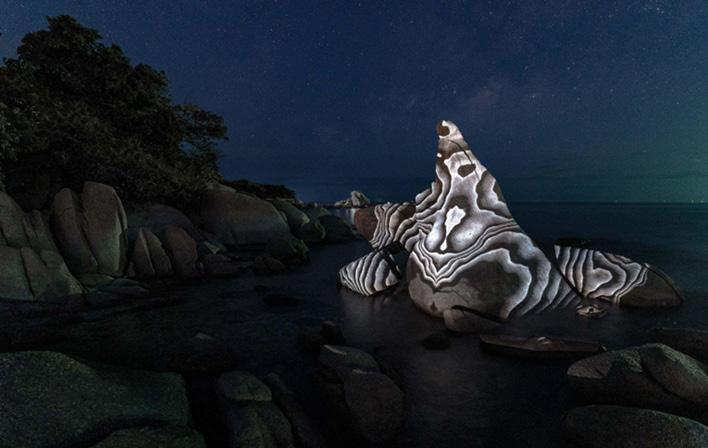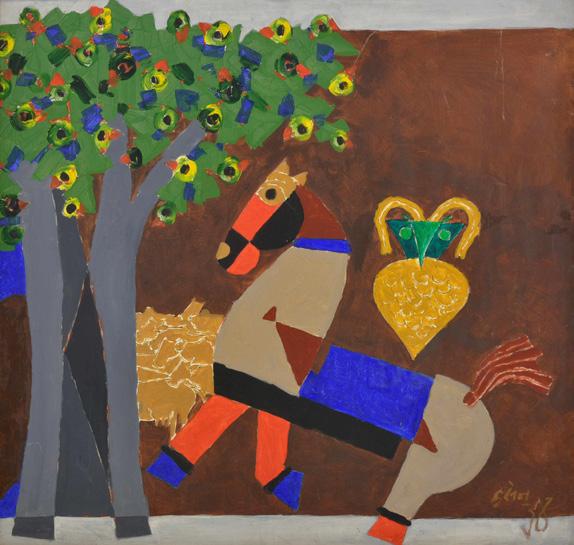
8 minute read
Land art exhibition in Ladakh
Sa, which means ‘soil’ in the Ladakhi language, is South Asia’s highest contemporary land art group exhibition held at 3600m altitude in Ladakh
Prayagraj, June 16 (IANS) Plans are afoot to convert the age-old film centre located in Prayagraj's Civil Lines area into a museum. The proposed museum will showcase the rich legacy of the film history of North India.
Advertisement
An amount of around Rs 4 crore will be spent on the project, said officials.
The dilapidated centre which was once part of education extension department, was earlier proposed to be auctioned a few years ago.
The new museum will be one of its kind.
The Smart City authorities would be taking the help of Indian National Trust for Art and Cultural Heritage (INTACH) for making this closed centre a museum.
The centre was established in 1938 to make educational films during the British rule and was the only film centre in North India at the time.
Mission manager (technical) of Prayagraj Smart City Limited, Sanjeev Sinha said: "After reading the history of the movie centre, it was found that the projector and sound system here was better than the cinema halls of Mumbai. Projectors were taken from the centre in buses to show films in schools and other places and big stalwarts of the cinema world used to come to the cinema hall to give lectures to the students of cinema."
After converting it as the film museum of North India, it will be the centre of attraction for the tourists as well, he added.
In its hey days, the Centre used to make short films to propagate education and as such it had the best cameras, high quality trolleys, cranes, and recording equipment of those times. But since 1990, the process for making educational films was discontinued and all the equipment has been locked up since then.
The Centre had made films on Maithilisharan Gupta, Sumitranandan Pant, Mahadevi Varma, Acharya Mahavir Prasad etc.
Also, films were made on biographies of Mahatma Gandhi, former President Rajendra Prasad, former Vice President Dr Radhakrishnan, former Prime Minister Jawaharlal Nehru, Indira Gandhi, Madan Mohan Malviya etc.
Luminous Legacy
Commemorating the 75th Anniversary of the Progressive Artist Group (PAG)
By Sukant Deepak
June 27, 2023 (IANSlife) Sa, which means ‘soil’ in the Ladakhi language, is South Asia’s highest contemporary land art group exhibition held at 3600m altitude in Ladakh.

To be organised from August 1 to 23, the exhibition will focus on climate, culture, and community in high-altitude environments.

Sa Ladakh will feature works by Ladakhi, Indian, and international; Nikolaus Geyrhalter, Phillip Frank, Sharbendu De, Jigmet Angmo, Vibha Galhotra, Skarma Sonam Tashi, Tsering Gurmet Kungyam, Sagardeep Singh and Tsering Motup.
“The inclusion of local artists is a testament to the growing recognition of contemporary art from the region on a global scale", as highlighted by Dr. Monisha Ahmed, co-founder of Ladakh Arts and Media Organisation (LAMO) and Sa co-curator. The festival will also include projection and video art at night.
Artists such as Philipp Frank from Germany, internationally known for his projections in nature, will explore connections between spirituality and the natural world. The exhibition will be set against the scenic backdrop of Disko Valley near Leh, a land strip, used by the local youth to express themselves and celebrate, hosting a downhill mountain bike path and breathtaking views. In the heart of Disko Valley, will offer an immersive experience through captivating site-specific art installations, cutting-edge video projections, and sculptures.

Raki Nikahetiya, the co-founder of Sa Ladakh, said, "Our primary focus will be on a 20-acre expanse of land, where we will delve into our interpretation of 'climate optimism.' Through the medium of land art, our aim is to foster an inclusive dialogue on climaterelated issues, engaging and inspiring communities amidst the breathtaking yet delicate Himalayan landscape."
Supported by LAMO, Snapchat, and Plus.tv, Let Me Breathe, the Australian Cultural Forum, the embassies of Germany and Switzerland, to India, and Local Futures, amongst other partners, the exhibition will be open to the public from 11 a.m. - 5 p.m.
The final list of participating artists and programming will be announced in early July 2023.
By IANSlife
June 24, 2023 (IANSlife)
Masterpieces from the iconic masters, dating back to their early years, will be on display in an exhibition, "Luminous Legacy", commemorating the 75th Anniversary (Diamond Jubilee) of Progressive Artist Group (PAG). The exhibition is being held in collaboration with the Raza Foundation and Triveni Kala Sangam, two prestigious institutions that have supported art and artists for decades.

With a preview on June 29, the exhibition, showcasing well over 30 works from legendary M F Husain, S H Raza, F N Souza, K H Ara, H A Gade, and S K Bakre will be showcased in Shridharani Art Gallery, and Triveni Gallery at Triveni Kala Sangam, from June 30 to July 10.


"The PAG had a plural vision of art: It accommodated different styles, idioms, art practices, and aesthetic approaches... The show is a modest attempt to underline their continuing presence and relevance," said Ashok Vajpeyi, Managing Trustee, of Raza Foundation.

A young woman who wants to use an unexpected legacy to revive an Australian outback town, a retired professor saddled with the responsibility of taking six children to safety through Nazi-invaded France, a dying salesman determined to repay some wartime debts, and a barmaid who seeks to clear her pilot paramour of a 'friendly fire' charge were among the protagonists in the singular stories of this once popular author.
Yet like many other of his contemporaries or successors - Frederick Forsyth, Desmond Bagley, Jack Higgins, Alistair Maclean, et al - with whom his works usually adorned bookshelves in houses of avid readers in the late 20th century, Nevil Shute has gradually faded away from public memory and interest.

An accomplished aeronautical engineer and pilot, who began writing novels as a hobby, Shute was much in demand for most of the 20th century, with his two-dozen-odd engrossing and eminently readable books with compelling plot lines - straddling various genres from romance to redemption, religion to reincarnation, and cross-cultural relations to a post-apocalyptic scenario, and sometimes, some supernormal elements - but not enough to stretch credulity.
Exotic and unconventional settings - spanning from South Pacific islands to dense Canadian forests to the Australian outback, themes revisited without getting repetitive, and sometimes, a framing device of a narratorwho introduces the main story but otherwise does not take partwere other features of his books. However, while many of his works made the transition to films, he deserves more appreciation for the new ground he broke. Most of his heroes were middle-class professionals - lawyers, doctors, bank managers, engineers, and most of them have some flaws, or other shortcomings - and the dignity of work and service is particularly emphasised. And most importantly, his handling of class, gender, and race relations most unprecedented for his era - given that he began writing from the mid-1920s when these issues were far placed from what we are familiar with in our age. His politics were a bit more conventional and even a bit reactionary - but not out of the ordinary for his time.
Nevil Shute Norway (1899-1960) shortened his author's name to Nevil Shute to guard his engineering career "from any potential negative publicity" from his novels - as per his memoirs (the predictably-named 'Slide Rule: Autobiography of an Engineer', 1954).
However, he shouldn't have bothered - being as renowned in his engineering endeavours, including having a key role in developing the R100 airship for Vickers and then heading his own aircraft construction firm that made a multi-engine bomber trainer for the Royal Air Force during World War II. This background was well reflected with Shute's heroes often being pilots or even aircraft designers - 'No Highway' (1954) has metal fatigue of the aircraft chassis as a key plot point!
He begin writing in 1923 though his first two (novellas 'Stephen Morris' and its continuation 'Pilotage' (1923-24), about a young pilot taking a dangerous mission) were only posthumously published in 1961, and his first published work was 'Marazan' (1926), where an escaped convict, framed for drug-running, rescues a pilot who helps him clear his name.
The next was 'So Disdained' (1928) where the protagonist, who discovers his friend is spying for the Soviets, does not report him but surreptitiously foils his bids - and finally takes on Soviet spies with the help of Italian fascists! (remember it is pre-Hitler times).
'Lonely Road' (1932) was, however, where Shute displayed his flair for innovative writing with a surrealistic, dreamlike first chapter and his first flawed hero, in this case, one foiling a conspiracy to influence the coming British elections.
A masterly intertwining of romance and an attempt (not all ethical) to revitalise a community - impacted by lack of economic opportunities - was explored in 'Ruined City' (1938) - a theme Shute would reprise in the more famous 'A Town Like Alice' (1950), which also brings in the horrors of the war in the Far East - and as well the resilience of people who faced them.
'What Happened to the Corbetts' (1938), which was prescient about the effects of aerial bombing of cities, can be considered the first of his WWII novels.
The others were 'Landfall: A Channel Story' (1940), where a young RAF pilot comes under a cloud after sinking a 'British' submarine before his girlfriend comes to his aid, 'Pied Piper' (1942) about an elderly teacher on holiday in France suddenly responsible for taking seven children to safety as the Germans invade, and 'Pastoral' (1944) about an unhappy love affair impacting a bomber pilot's performance and imperilling his crew - it climaxes with an unforgettable scene with the hero, alone in his damaged aircraft waiting for the time till he can safely land.
Shute's wartime-themed works also included 'Most Secret' (1942) about unconventional attacks on Germans on the French coastbut due to its sensitive nature, its release was held back till the war ended.
The fanciful 'An Old Captivity' (1940) about a pilot, in Greenland on a mission, suffering a drug-induced flashback to the Viking era, was the first with a supernatural theme - a motif that would be reprised in 'In the Wet' (1953), with some extraordinary time travel, and criticism of socialism.
The sombre 'Requiem for a Wren' (1955), set in Australia, could also be included here as all its protagonists are grappling with the effects of the war.
Shute's postwar works grew a bit more to be vehicles of his viewsdislike of post-war Britain (which led him to emigrate to Australia in 1950) figures in 'The Far Country' (1952) and of the 'White Australia' policy in 'Round the Bend' (1951) - his own favourite - about an aircraft engineer finding a new religion based on good work. While cross-cultural romance
'Beyond the Black Stump' (1956), and unconventional romance 'The Rainbow and the Rose' (1958) are part of his Australian corpus, his most famous novel (thanks to its film adaptation starring Gregory Peck and Ava Gardner) was the dark 'On the Beach' (1957) about a nuclear holocaust depopulating most of the world and a few survivors in the Melbourne region living it up as they await their turn.
However, for those piqued by Shute, three of his representative best could begin with 'Round the Bend' - which has usual Shute tropes - aviation professionals as heroes, exotic locales spanning from the Gulf to South Pacific in a thought-evoking story.
'The Chequer Board' (1947) is about a cereal salesman, after a wartime wound is pronounced a death sentence, wondering about what happened to three distressed comrades in a hospital and decides to use his remaining time to find out. The search for the three - a rather immature RAF pilot concerned about marital infidelity, a commando accused of murder, and a black GI, who attempted suicide after being accused of rape - is eyeopening. Then there is his final novel 'Trustee from the Toolroom' (1960), showcasing how a mildmannered English mechanical whiz, working in a low-paying job at a specialised technical newsletter, has to mount a desperate mission into South
Pacific to safeguard the legacy of his recently-orphaned niece, how he fares on a "mission impossible" that takes him all around the








